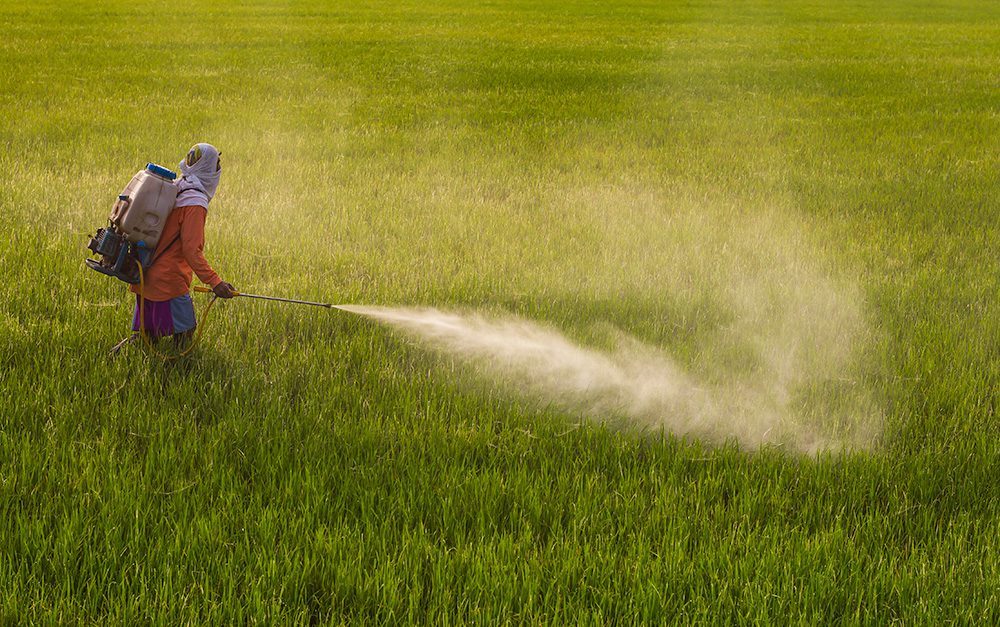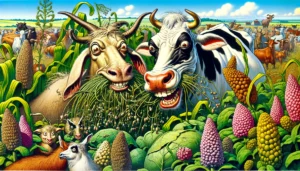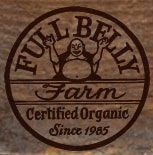
pesticide.jpg
Pesticide
Definition: A pesticide is any substance or mixture of substances used to control, repel, kill, or mitigate pests, including insects, weeds, pathogens, rodents, nematodes, and other organisms that pose threats to crops, livestock, humans, or the environment. Pesticides play a critical role in modern agriculture by protecting crops from pests, diseases, and weeds, ensuring food security, and supporting agricultural productivity and profitability.
Description: Pesticides encompass a wide range of chemical, biological, and physical agents designed to manage pest populations and reduce their negative impacts on agricultural production, public health, and environmental quality. They include insecticides, herbicides, fungicides, rodenticides, nematicides, molluscicides, acaricides, avicides, and repellents, as well as plant growth regulators, pheromones, traps, baits, and biopesticides derived from natural sources.
Fall off the barn roof and busted your keister? Life on the farm or ranch can be tough on the bum. Need a break? Laugh it off at FarmerCowboy.com, the #1 farm humor site. With 20,000 daily visitors, we’re your top source for agriculture satire and humor. Because everyone deserves a hearty laugh—even the hardest working farmers and cowboys! Join us and turn those long days into fun tales at FarmerCowboy.com.
Types of Pesticides: Pesticides can be classified into several types based on their target pests, mode of action, chemical structure, persistence, and application method. These include:
- Insecticides: Chemical compounds or biological agents designed to control insect pests by disrupting their nervous system, metabolic processes, or reproductive functions, such as organophosphates, carbamates, pyrethroids, neonicotinoids, and biological control agents such as Bacillus thuringiensis (Bt) or parasitoid wasps.
- Herbicides: Chemical substances or formulations used to kill or inhibit the growth of unwanted weeds, grasses, or invasive plants by disrupting photosynthesis, cell division, or hormone synthesis, such as glyphosate, atrazine, 2,4-D, dicamba, and glufosinate.
- Fungicides: Chemical compounds or biological agents applied to control fungal diseases, molds, mildews, and other plant pathogens by inhibiting spore germination, mycelial growth, or enzyme activity, such as copper-based fungicides, triazoles, strobilurins, and biological control agents such as Trichoderma spp. or mycorrhizal fungi.
- Rodenticides: Toxic baits or poisons used to kill or control rodent pests such as rats and mice, either through ingestion or contact, by disrupting blood clotting, nervous system function, or cellular respiration, such as anticoagulant rodenticides, bromadiolone, brodifacoum, zinc phosphide, or cholecalciferol.
- Nematicides: Chemical compounds or biological agents applied to control nematode pests in soil or plant roots by disrupting cellular function, enzyme activity, or reproduction, such as organophosphates, carbamates, fumigants, and biological control agents such as nematophagous fungi or predatory nematodes.
- Molluscicides: Chemical formulations used to control mollusk pests such as snails and slugs by poisoning or repelling them from crops, gardens, or water bodies, such as metaldehyde, iron phosphate, copper sulfate, or biological control agents such as nematodes or bacteria.
- Acaricides: Chemical substances or formulations applied to control mite and tick pests on crops, animals, or humans by disrupting their nervous system, respiratory system, or reproductive cycle, such as organophosphates, pyrethroids, abamectin, or biological control agents such as predatory mites or entomopathogenic fungi.
- Avicides: Toxic baits or chemicals used to control bird pests such as pigeons, starlings, or gulls by inducing lethargy, disorientation, or mortality through ingestion or contact, such as avian repellents, toxicants, or frightening devices.
- Repellents: Substances or formulations applied to deter or repel pest animals or insects from crops, structures, or human habitats through olfactory, gustatory, or tactile stimuli, such as animal repellents, insect repellents, or botanical extracts.
Pesticide Application: Pesticides are applied to crops, soil, water, structures, or animals using various methods depending on the pest type, pest life stage, infestation level, crop stage, environmental conditions, and regulatory requirements. These include:
- Foliar Spraying: Applying liquid pesticide formulations directly to plant foliage using handheld or mechanized sprayers, booms, or drones, covering leaf surfaces with uniform spray droplets to target pests and diseases effectively while minimizing spray drift and environmental contamination.
- Soil Drenching: Applying liquid pesticide formulations to soil around plant roots or in planting holes using drip irrigation, soil injectors, or watering cans, allowing roots to absorb systemic pesticides and translocate them throughout the plant to control soil-borne pests or diseases.
- Seed Treatment: Coating seeds with pesticide formulations containing fungicides, insecticides, or nematicides before planting using seed treating machines, seed drills, or seed coating drums, protecting seeds from soil-borne pathogens, pests, or environmental stresses during germination and early growth stages.
- Fumigation: Releasing gaseous pesticide formulations, such as methyl bromide, phosphine, chloropicrin, or sulfuryl fluoride, into enclosed spaces, storage facilities, or soil profiles using fumigation chambers, tents, or applicators, penetrating substrates to control pests or pathogens effectively while minimizing residues and environmental exposure.
- Trapping and Baiting: Deploying pesticide-laced baits, traps, or attractants to lure and capture target pests such as insects, rodents, or birds using pheromone traps, sticky traps, light traps, live traps, or bait stations, reducing pest populations through monitoring, mass trapping, or population suppression strategies.
Benefits of Pesticides: Pesticides offer several benefits to agriculture, including:
- Pest Control: Effectively controlling pest populations, diseases, and weeds that threaten crop yields, quality, and profitability, reducing crop losses, post-harvest losses, and economic damage caused by pests, and ensuring food security, stability, and availability for growing populations.
- Crop Protection: Protecting crops, fruits, vegetables, ornamentals, and turf from damage or destruction by insect pests, fungal pathogens, bacterial diseases, nematodes, weeds, and other pests, preserving plant health, vigor, and aesthetics for optimal growth and marketability.
- Disease Prevention: Preventing the spread of plant diseases, viral infections, fungal outbreaks, or bacterial epidemics within agricultural ecosystems, orchards, vineyards, and nurseries, minimizing disease transmission, contamination, and quarantine risks, and safeguarding plant health and genetic diversity.
- Weed Management: Managing weed infestations, invasive species, or herbicide-resistant weeds that compete with crops for water, nutrients, light, and space, suppressing weed growth, preventing yield losses, and improving crop establishment, yields, and profitability through effective weed control strategies.
- Public Health: Protecting public health and safety by controlling disease vectors, such as mosquitoes, ticks, flies, and rodents, that transmit pathogens, parasites, or zoonotic diseases to humans, reducing disease incidence, morbidity, mortality, and healthcare costs associated with vector-borne illnesses.
- Environmental Stewardship: Promoting sustainable agriculture practices, integrated pest management (IPM) approaches, and reduced-risk pesticide alternatives to minimize pesticide use, residues, and environmental impacts on soil, water, air, wildlife, beneficial insects, pollinators, and non-target organisms.
Challenges and Concerns: Pesticide use also poses challenges and concerns, including:
- Environmental Pollution: Pesticide residues, runoff, drift, or leaching can contaminate soil, water, air, and ecosystems, leading to ecological imbalances, biodiversity loss, habitat destruction, and adverse effects on non-target organisms, such as pollinators, aquatic organisms, birds, and wildlife.
- Human Health Risks: Exposure to pesticides through inhalation, ingestion, or dermal contact can pose health risks to farmers, farm workers, pesticide applicators, consumers, and communities, including acute poisoning, chronic health effects, reproductive disorders, developmental abnormalities, and neurological impairments.
- Pesticide Resistance: Prolonged or repeated use of pesticides can lead to the development of resistance in pest populations, reducing pesticide efficacy, control effectiveness, and economic returns, necessitating alternative pest management strategies, pesticide rotations, or integrated approaches to delay resistance and preserve pesticide efficacy.
- Non-Target Effects: Pesticides may harm beneficial insects, natural enemies, pollinators, and wildlife through indirect or unintended exposure, disrupting ecosystem services, biological control mechanisms, and food webs, and undermining biodiversity conservation efforts and ecosystem resilience.
- Regulatory Compliance: Compliance with pesticide regulations, registration requirements, label instructions, safety precautions, and application guidelines is essential to prevent pesticide misuse, illegal use, environmental violations, liability claims, litigation, and regulatory sanctions, ensuring responsible pesticide stewardship and public trust in agricultural practices.
Conclusion: Pesticides are valuable tools for pest management in agriculture, protecting crops, public health, and the environment. By adopting integrated pest management (IPM) strategies, promoting sustainable agriculture practices, and investing in pesticide research, education, and stewardship, stakeholders can minimize pesticide risks, optimize pest control, and achieve balanced and resilient agricultural systems.
References:
- Pimentel, D. (2009). Environmental and economic costs of the application of pesticides primarily in the United States. Environment, Development and Sustainability, 11(3), 555-570.
- Casida, J. E., & Quistad, G. B. (2018). Golden age of insecticide research: past, present, or future? Annual Review of Entomology, 63, 423-442.
- Pretty, J., et al. (2006). Resource-conserving agriculture increases yields in developing countries. Environmental Science & Technology, 40(4), 1114-1119.
Originally posted 2022-05-19 06:07:45.
Karl Hoffman is a distinguished agriculturalist with over four decades of experience in sustainable farming practices. He holds a Ph.D. in Agronomy from Cornell University and has made significant contributions as a professor at Iowa State University. Hoffman’s groundbreaking research on integrated pest management and soil health has revolutionized modern agriculture. As a respected farm journalist, his column “Field Notes with Karl Hoffman” and his blog “The Modern Farmer” provide insightful, practical advice to a global audience. Hoffman’s work with the USDA and the United Nations FAO has enhanced food security worldwide. His awards include the USDA’s Distinguished Service Award and the World Food Prize, reflecting his profound impact on agriculture and sustainability.



